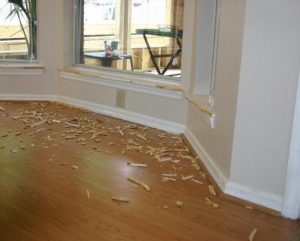Contents

Photo courtesy of Kim Hannah
We have heard it said many times, “behavior has a reason.” This is the case for every species that breaths. Some behaviors are innate, meaning they are performed for survival and do not need to be taught. It is a behavior that is instinctual and passed down through genes. Innate behavior is fully developed at the time of the animals’ birth. An example with a parrot is flight.
Learned behavior is a taught behavior starting in the nest. It is something an animal discovers to be beneficial through observation, trial, and error. Learned behavior can adapt over time to suit changing conditions. An example is a parrot playing with a foraging toy.
Know The Behavior Types And Consequences
As good stewards of our parrots, we need to understand both types of behavior and how to work with them. Many people I talk with through my consulting business have a difficult time distinguishing the different behaviors and how to make it work so they can coexist peacefully together.
A “cute” behavior that a caregiver may have encouraged in the beginning, became a learned behavior that was adapted and perfected by the parrot to suit his/her needs. An example of this would be the bird walking the floor, and the end result is chasing and biting feet. Lesser sulfur-crested cockatoos are often known for this particular behavior. I grew up in a house with one. No one could walk in the house without slippers and, during mating season, we switched to sneakers. Sadly, no one would take my advice and try to change this behavior and make it safer for all involved. After all, what did some young kid know?
After I got married and moved out, this cockatoo was gravely injured by a visitor who did not know there was a white thing on the floor that was going to attack. Who paid the ultimate price for bad stewardship? The bird.
A Not-So-Good Walk

Foot chasing could easily have been extinguished early on by not ever allowing this cockatoo on the floor. That experience has probably shaped me into not welcoming any of mine on the floor. There have been very few times in my life that my birds have been on the floor and given any opportunity to explore. To this day, should they fly or fall to the floor they stand there and look for someone to pick them up. It never mattered the species. I just did not want any bird chasing anyone or getting into other trouble, such as chewing things they should not.
The Need To Nest
That brings us to another reason a bird should be kept up off the floor. If anyone has recently watched the Lafeber’s webinar with Dr. Lamb, DABVP (avian practice) from Arizona, the subject of hormones and nest making was discussed. A lot of people who reach out to me have this issue.
Birds of all species will search out a spot to do what comes natural during hormone season, and that is to seek out a safe place to make a nest and redecorate the area to suit their needs. That may be under your great grandmother’s Queen Victoria hutch, your new kitchen cabinets, in your bathroom behind your toilet, or any other safe, darker spot.
This behavior of nest building and raising babies is an innate behavior. It is survival; it does not need to be taught. It is something that all parrots eventually show interest in. People often then get upset that their furniture or wall was destroyed in the process. This is not the bird’s fault, and it is harder to change this behavior once it has been welcomed by the caregiver.
Being in a perpetual state of wanting to nest and raise chicks can have devastating results on the parrot. Both emotional and medical. How do we prevent this? One way is to keep the bird off the floor. Work on behaviors and deter unacceptable ones.
Preventing Hormonal Walks
So, what happens if you already have a bird that is used to being on the floor? How can you change that? Be aware of how your bird is getting to the floor. Are you the vector or are they shimmying down the leg of the cage? Often, people who just open the door to the cage and let the bird roam have issues of the bird going on the floor to look for things to do.
A simple way to deter that behavior is to give your bird something else to do in an area that is not as easy to get to the floor. Many play stands are designed that a bird can easily get down via a leg. Keep that in mind when purchasing such an item if you have issues. An actual tree stand is harder to get off of. The trunk of the tree makes it near impossible to climb down.
Other gym products can be hung from the ceiling to keep your bird entertained. Look at every design detail of play areas you have or are thinking of buying. Once you have a designated parrot stand/area in your home, make sure that area is fun. Don’t expect a parrot to just sit there and be good, because they won’t.
Some people will say they enjoy the interactive time the bird and they have on the floor playing with toys. That interaction does not need to stop, but move it to another area. Place a sheet on your bed or couch and play there.
As stewards we can prevent bad behavior if we try. We just need to keep up the training and not get lax, as so many do. We can get positive outcomes, shape desirable behavior, and keep those learned behaviors in check.






Good information! I learned some things I did not know. I have a grey that loves the floor. He gets aggressive on the floor and it gets harder and harder to pick him up. I am going to make a bigger effort to get him up on to a rope perch or play stand now
Wish I read this ten years ago
I never stop my gray from walking around
I will start
Thank you, Lisa! Very informative
Both my 17 year-old cockatiel and my one-year old blue crown conure have ladders to get to their cage and the floor. The cockatiel, male, sometimes finds a dark spot and rocks from side to side. He gets very upset if someone comes too close. The conure loves to climb so he has his gym. My only problem with the Conure, other than the darn biting, is that when we’re playing, or whenever, he feels like it, he screams. However, when I’m not in the area, he’ll play by himself and talks. He very rarely screams when I’m not around. Can you help me stop that behavior? I figure it has something to do with me but I’m baffled. Otherwise, they are such fun.
What if you have a non-flying/poor-flying parrot? How is she to be an active part of the family without being able to join them from room to room?
Thank God I have never let my birds wonder on the floor for safety of my birds as well as visitors, family, other pets and costly repairs from damages. I really appreciate your article.
Thank you, I am waiting for my Indian Ringneck to be weaned, this is good what not to do information.
My conures go on the floor to pick up treats they dropped, or some other bird did.
Sometimes both my conures come to the floor to play with my dog, or groom the cat.
My birds have never destroyed anything in the house, maybe because they have different foraging toys in their cages. They HATE any purchased toy. I make all their toys and they love it. I have a GCC if each sex, then male Quaker and Moustache Parakeet. I hope to finish my flock with either an amazon or Hans macaw
I do not clip the wings on my Moluccan cockatoo. After 22 years she is still free flight, from cage to stand to chair. Her huge cage has plenty of toys and she never hesitates to go home when asked. She is a lovely, happy bird and a great companion. I rescued her from a miserable life, cramped cage, only seed to eat, no fresh veges or nuts and she screamed all the time! I let her wings grow out, let her fly and she became the wonderful bird she is today.